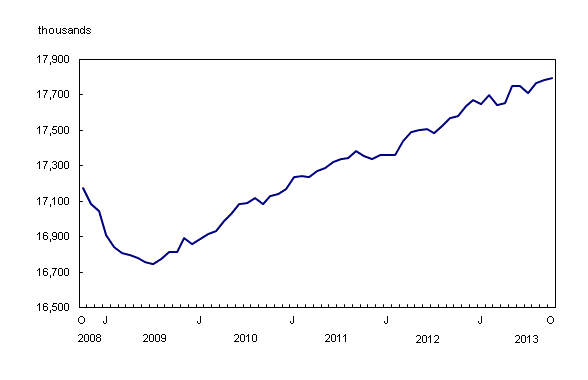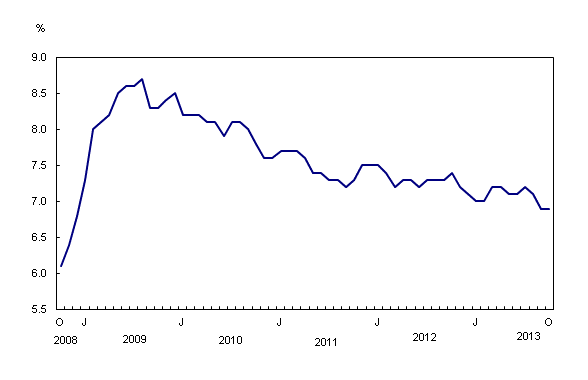Labour Force Survey, October 2013
Archived Content
Information identified as archived is provided for reference, research or recordkeeping purposes. It is not subject to the Government of Canada Web Standards and has not been altered or updated since it was archived. Please "contact us" to request a format other than those available.
Released: 2013-11-08
Employment was little changed for the second consecutive month and the unemployment rate remained at 6.9% in October.
Compared with October 2012, employment increased by 1.2% or 214,000, with gains in full-time and part-time work. Over the same period, the number of hours worked rose by 1.4%.
Provincially, employment increased in Quebec, Newfoundland and Labrador and in Prince Edward Island. At the same time, there were declines in Nova Scotia, Manitoba and New Brunswick.
In October, there were more people working in accommodation and food services, health care and social assistance as well as public administration. However, employment declined in business, building and other support services.
The number of public sector employees increased in October, while there was little change among private sector employees and the self-employed.
Provincial employment
Employment in Quebec rose by 34,000 in October. The unemployment rate, at 7.5%, was similar to the rate observed in September, as more people participated in the labour force. Compared with a year earlier, employment in this province was little changed.
There were 4,000 more people working in Newfoundland and Labrador, bringing employment in the province to about the same level as 12 months earlier. Despite this monthly increase, the unemployment rate rose 0.6 percentage points in October to 11.0% as more people were looking for work.
While employment was little changed in Saskatchewan in October, the unemployment rate fell 0.7 percentage points to 3.6%, the lowest of all provinces. Year-over-year employment growth was 3.1%, second only to Alberta at 3.5%.
There were 3,300 fewer Nova Scotians working in October, leaving employment in Nova Scotia at a level similar to that of October 2012. The unemployment rate increased 0.5 percentage points to 9.1%.
Employment in Manitoba decreased by 3,000 in October. At the same time, there was a similar decline in labour force participation, leaving the unemployment rate unchanged at 5.5%. The number of people working in the province was little changed compared with 12 months earlier.
Following an increase in September, the number of people working in New Brunswick fell by 2,500 in October, leaving employment at about the same level as October 2012. The unemployment rate in the province fell by 0.6 percentage points to 10.1% as fewer New Brunswickers were looking for work.
Industry perspective
There were 30,000 more people employed in accommodation and food services in October, bringing employment gains in the industry to 78,000 (+7.2%) since October 2012.
Employment in health care and social assistance rose by 20,000, contributing to the year-over-year increase of 48,000 (+2.2%).
The number of employees in public administration increased by 19,000 in October. However, employment in the industry has been on a downward trend since February, declining by 5.2% or 52,000 over this eight-month period.
Employment in business, building and other support services declined by 33,000 in October, bringing employment in the industry back to its level of 12 months earlier.
There were 47,000 more people working in the public sector in October, with most of the gains in health care and local public administration. On a year-over-year basis, all of the employment increase was among private sector employees, up 1.8% (+205,000), as there was little overall growth in self-employment and public sector employment.
Little change in employment among demographic groups
Employment for youths aged 15 to 24 was little changed for the third consecutive month. Over the past 12 months, however, youth employment increased 1.6%. As for their unemployment rate, it rose by 0.5 percentage points to 13.4% in October, the result of more youths looking for work.
For the second consecutive month, there was no notable employment change among people aged 25 to 54, and the employment level for this age group remained similar to that of October 2012.
In October, employment among men and women aged 55 and over was little changed. However, compared with 12 months earlier, employment for this group was up 144,000 (+4.4%), the result of both employment growth and population ageing.
Note to readers
The Labour Force Survey (LFS) estimates are based on a sample and are therefore subject to sampling variability. As a result, monthly estimates will show more variability than trends observed over longer time periods. Estimates for smaller geographic areas or industries also have more variability. For an explanation of sampling variability of estimates and how to use standard errors to assess this variability, consult the "Estimates quality" section of the publication Labour Force Information (Catalogue number71-001-X).
The employment rate is the number of employed persons as a percentage of the population 15 years of age and over. The rate for a particular group (for example, youth aged 15 to 24) is the number employed in that group as a percentage of the population for that group.
The unemployment rate is the number unemployed as a percentage of the labour force (employed and unemployed).
The participation rate is the number of employed and unemployed as a percentage of the population. For more detailed information, see the Guide to the Labour Force Survey (Catalogue number71-543-G).
Unless otherwise stated, this release presents seasonally adjusted estimates, which facilitates comparisons by removing the effects of seasonal variations. For more information on seasonal adjustment, see Seasonal adjustment and identifying economic trends.
Each year, the LFS revises its estimates for the previous three years, using the latest seasonal factors.
A more detailed summary, Labour Force Information (Catalogue number71-001-X), is now available online for the week ending October 19. From the Browse by key resource module of our website under Publications, choose All subjects, then Labour.
Data tables are also now available online. From the Browse by subject module of our website, choose Labour.
The next release of the Labour Force Survey will be on December 6.
Contact information
For more information, contact us (toll-free 1-800-263-1136; 514-283-8300; infostats@statcan.gc.ca).
To enquire about the concepts, methods or data quality of this release, contact Vincent Ferrao (613-951-4750; vincent.ferrao@statcan.gc.ca) or Lahouaria Yssaad (613-951-0627; lahouaria.yssaad@statcan.gc.ca), Labour Statistics Division.
- Date modified:



